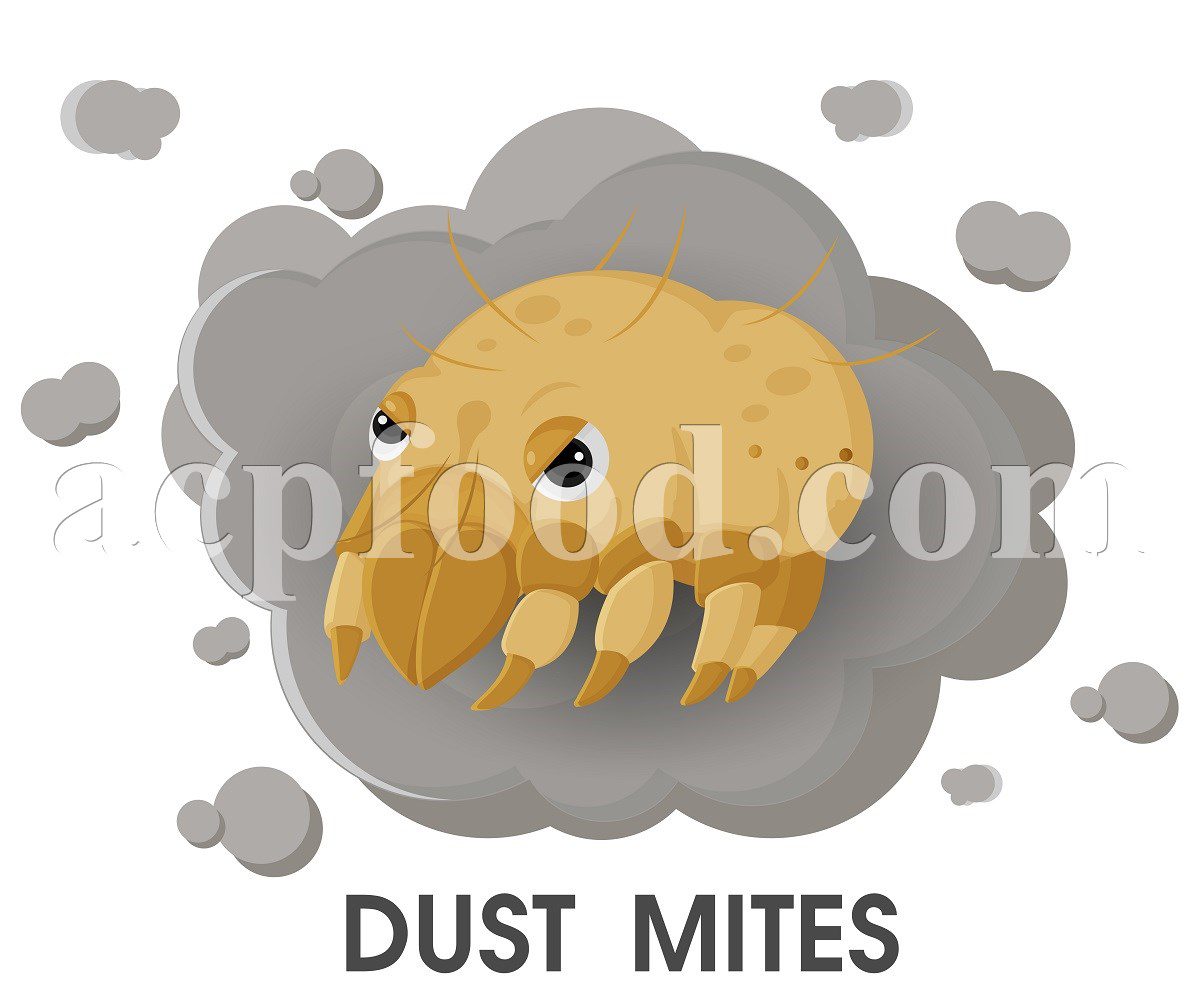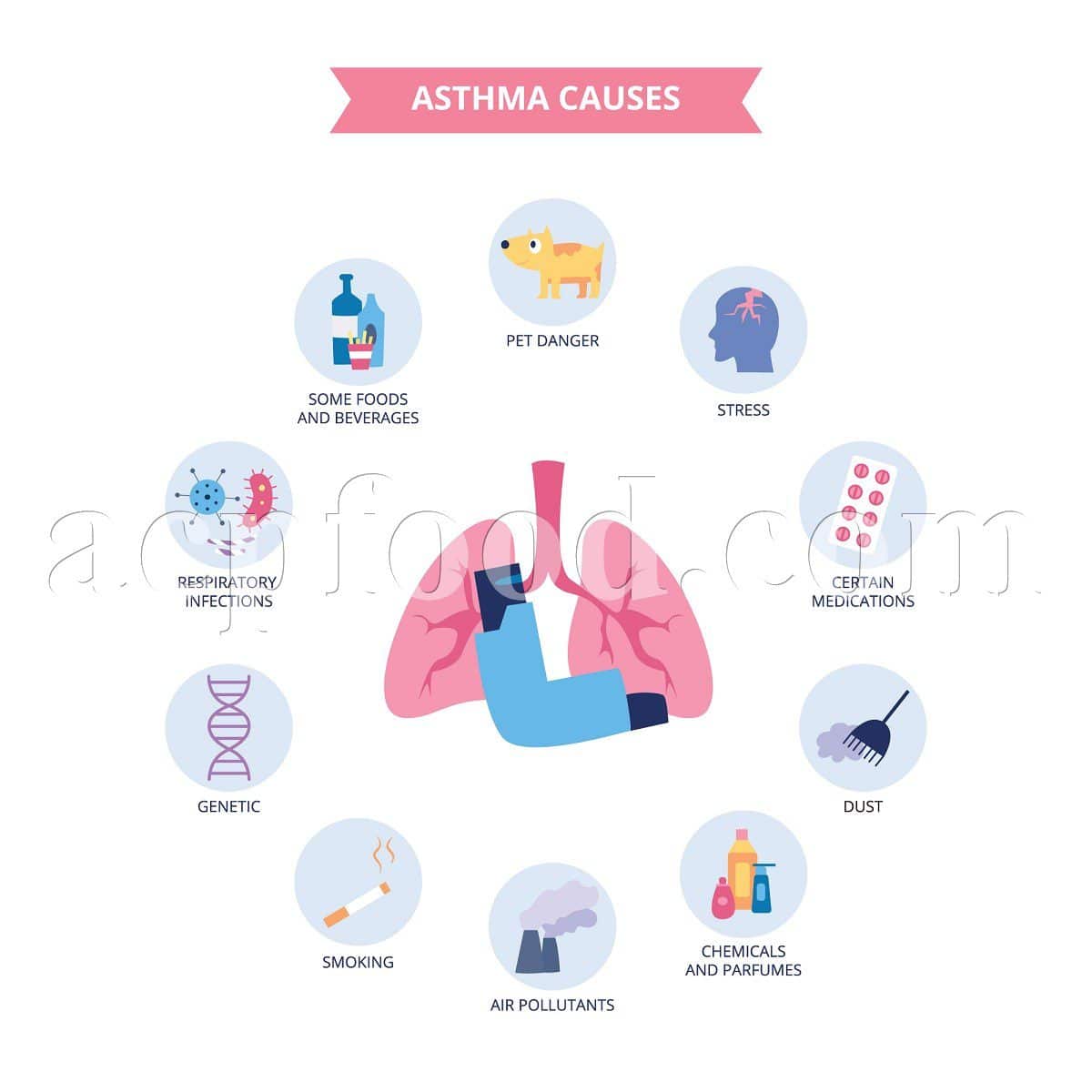
Most people know asthma as attacks of shortness of breath with wheezing that occur in children and adults. These attacks can occur during activity or while resting and may be mild or severe. The word asthma is a term used to describe diseases characterized by attacks of shortness of breath caused by intermittent narrowing of the airways or bronchial tubes (in the lungs).
Various factors are involved in the development of this disease. These factors vary from person to person. The best definition that can be given for asthma is: this is a condition where the airways of the lungs are inflamed, so they become very sensitive to certain factors.
Table of Contents
Trigger Factors of Asthma Attacks
These factors cause the airways to become narrow and the flow of air through it decreases, causing shortness of breath or wheezing. Therefore, asthma is not just a specific disease, but has several different patterns.
Also read it: Cleansing The Lungs From Cigarette Smoke With Iranian Traditional Medicine
It has different severities, different triggers, and different treatment in different people. For this reason, the treatment that is very useful for one patient may not be suitable for another patient.
Causes of Asthma Attacks
Most people know that this disease runs in some families. It means that there are a hereditary and genetic causes. Undoubtedly, in allergic asthma (Extrinsic Asthma), heredity and genetic factors are very important, while in non-allergic asthma (Intrinsic Asthma), heredity factors are not very important.
How Does It Start?
The genetic factor and heredity in the occurrence of this disease is not like inheriting the children eye color or blood type from their parents, but a patient with severe asthma can have children who never suffer from this disease. The role of environmental factors (such as sensitizers or allergens and a person’s exposure to cigarette smoke) can be very important in the occurrence of it and its exacerbation. However, these factors do not cause asthma in everyone.
House Dust Mites and Other AgentsApart from hereditary and genetic factors, many factors are responsible for the initial occurrence of this disease in people. For example, first-onset asthma in adults often follows a cold or a viral infection. Also, exposure to irritants in the workplace may be one of the factors that trigger its attacks. However, the most important cause of these attacks (especially in children) is exposure to house dust mites. Mites are small and microscopic creature that are smaller than the tip of a needle. These small animals live in carpets, rugs, quilts, mattresses, blankets, and children’s woolen toys. There may be about two million mites in each mattress. We should also know that only the proteins in the feces of these mites cause allergies and asthma. When a sensitive person is exposed to the feces of mites that are spread in the air for a long time, the white blood cells of this person become sensitive to this foreign object (mite feces). When the protein of mite feces enters the lung through inhalation, a reaction occurs in the bronchial mucosa and causes inflammation in the airways. |
 |
This inflammation causes the bronchial mucosa to become sensitive, so that any subsequent exposure to mites or any other irritating factor causes the bronchi to narrow and cause asthma symptoms.
Other things may also trigger its attacks, including smoking by the mother during pregnancy and being in a place where other people are smoking, which is very dangerous for children.
 |
Causes of AsthmaIn general, the causes include: heredity and genetics, mother’s smoking during pregnancy, children exposure to cigarette smoke, air pollution, allergens, colds and viral infections, exposure to allergens in the workplace (occupational asthma). The Prevalence of AsthmaThe prevalence of this disease is very high and it is estimated that today about 20% of primary school children and about 6-7% of the entire population have asthma. It is the most common disease in Western countries, so that in England and Wales, about three million people suffer from this disease. In children, the prevalence of it in boys is twice girls, while in adults, this disease is slightly more common in women than in men. This disease in children is increasing. |
The Main Provoking Factors in Asthma
In a sensitive person, any provoking factor can cause its attacks. Each person will soon understand what factors trigger their attacks. Doing exercises and playing, especially in children, can cause it. Although the problem of shortness of breath during sports activities often happens due to lack of physical readiness and when someone is not used to do exercise.
Allergens
Plant pollens are known irritants, and animals such as dogs, cats, horses, etc. can also cause these attacks. Long-term exposure to allergens such as animals or plants can cause persistent symptoms. But the importance of these factors may be ignored most the times.
Smoke, Perfume and Dust
Cigarette smoke can also cause asthma attacks for many patients. Also, environments that have a lot of dust and specific smells like perfume also cause it in sensitive people. The best treatment in such cases is to avoid dealing with such factors.
Colds and Viral Infections
Viral infections are the most common cause of asthma in all ages. Antibiotics are only effective in treating bacterial infections, which rarely cause these attacks. Antibiotics have no effect on viruses and therefore will not play a role in the treatment of this disease.
Emotions and Stresses
Children often experience wheezing during birthday parties because a combination of excitement, joy, sadness, and stress which can all be its triggers. It has been seen that patients who are suffering from asthma also developed it at the funeral of their relatives.
Also read it: Hijama (Wet Cupping)
Weather and Air Pollution
Many asthmatic patients believe that their condition gets better in certain weather and get worse in other weather. Some patients prefer cold and humid weather and others like hot and dry. It has not yet been scientifically proven what kind of climate is suitable for these people.
So, it can be said that it depends on the person, type of asthma and its cause. It is up to you to choose your favorite climate according to your habit and situation. Air pollution also plays an important role in aggravating asthma attacks (especially in patients with severe asthma).
Asthma Symptoms and Diagnosis
Asthma is often difficult to diagnose because its symptoms can easily be confused with symptoms of other respiratory diseases. A definitive diagnosis of it in a patient should be made after taking a complete history and performing numerous tests. Asthma is manifested by one or more of its four main symptoms. 1- wheezing. 2- Shortness of breath. 3- Cough. 4- Pressure on the chest.
Wheezing and shortness of breath are the most well-known symptoms of asthmatic patients and they usually occur intermittently when exposed to irritants. However, shortness of breath can occur without wheezing in these patients. One of the symptoms that most people do not recognize as a symptom of this disease is a cough.
As mentioned before, cough can be productive or non-productive and usually occurs at night or during sport activities. In many cases, the cough caused by asthma is considered to be bronchitis, the occurrence of more than two periods of stable cough (if it is without wheezing and shortness of breath) should suggest the existence of this disease. The fourth main cause of it is pressure on the chest.
Most of these symptoms occur during sports activities. When an elderly patient feels pressure on the chest, the diagnosis of cardiac angina is also raised. It may be very difficult for the doctor to distinguish between asthma and angina in such people.
Although asthma symptoms often occur without any clear reason, their characteristic is that they wake up the patient during the night and it often get worst when the patient wakes up in the morning. Asthma which wakes the patient up in the middle of the night indicates that it is not well controlled and treated.
Different Types of Asthma
In many cases, the cause of this disease is unknown, however, in some cases, an allergen is responsible for these attacks. Other different types of asthma include “Brittle Asthma”, “Aspirin-induced Asthma”, and “Nighttime Asthma”. If you suspect that your asthma is caused by some allergenic substances such as plants or the presence of animals such as horses, dogs, or cats at home, you should confirm this by doing an allergy test.
Allergic Asthma
Allergy is considered as one of the causes of your disease, it is necessary to perform tests to confirm this issue and identify the allergen. These tests are simple and take about half an hour to perform.
A number of drops consisting of different allergenic substances, such as house dust mites, grass pollen, tree pollen or hair of animals such as cats, etc., are placed on the forearm and the skin under each drop is gently pierced through the tip of a small needle, to allow the allergen to penetrate under the skin.
Also read it: Constipation in Traditional Iranian Medicine
After about 15 minutes a local reaction can occur in this area, which is like an insect bite. It gets red and usually itchy. Plunging the needle into the skin is not painful and is only a scratch, but the itching can be very intense and last for about half an hour.
The size of the reaction area (i.e. the amount of redness around the injection site) can be measured for any sensitizing substance, which can not only show if you are sensitive to that substance, but also how much you are allergic to a specific substance. Sometimes this information can be used in the treatment of the patient because with this information we understand what substances we should avoid and what substances cause problems for us.
Desensitization
If it is determined that you are allergic to a certain substance (for example, animal hair) and you cannot avoid contacting with these animals, and your asthma is not well controlled with medicine, it may be necessary to desensitize yourself to these substances.
Desensitization should only be done in specialized centers and only one substance should be desensitized at a time. This should be done only in the hospital for these patients because it has happened a lot that severe asthma attacks have occurred during desensitization, which required emergency and hospital measures, and if such emergency measures are not taken, the patient’s life will be threatened.
In the case of seasonal allergies (hay fever), these risks are less, but in the case of asthma, extreme care should be taken. The method of desensitization is that you are injected with several injections of a small amount of the substance you are allergic to (usually under the skin of the upper arm). so that the person does not have a severe allergic reaction. Small local reactions (redness at the injection area) are usually not common, but if they occur, they will disappear on the same day.
When a desensitization period is over, if it is successful, it is necessary to repeat the injections at certain time intervals. For desensitizing, a series of repeated injections is used, so that small amounts of the allergen are injected into the skin and this amount increases in subsequent injections so that the person can tolerate it.
Brittle Asthma
Brittle asthma is a rare type of this disease. Patients with this type have severe and sudden attacks, even when their disease appears to be well controlled. Some of these patients have already had a history of asthma and now their attacks have started again and the doctor can hardly control it.
Such patients are hospitalized because the risk of death due to asthma in these people is high. It seems that allergies or sensitivities are very common in these patients and sometimes their attacks are caused by inhaling or eating something they are allergic to.
Aspirin-Induced Asthma
Aspirin-induces asthma is seen in 5% of adult patients with asthma, but it is very rare in children, and most of these patients do not show anything in the skin sensitivity test to allergens (negative test).
These patients may also have nasal polyps. If you are among such patients, you should avoid taking aspirin and medicines that contain aspirin or similar substances such as ibuprofen, diclofenac sodium, indomethacin and mefenamic acid. Patients with aspirin-induces asthma or similar asthma may even die from taking such medicines.
Desensitization method can also be used in these patients. Desensitization for patients with aspirin-induces asthma is performed by using a very small number of aspirin orally in the hospital, and during this period, several breathing tests are performed for several hours after each aspirin intake. This will take some time. If you are allergic to aspirin, avoid taking it or the medicines that contain aspirin.
Nighttime Asthma
Nighttime Asthma refers to asthma that occurs at night. In fact, waking up in the middle of the night due to this disease indicates poor control in such people and may occur in any person with any type of asthma. In most cases, this problem can be overcome with appropriate treatment, but in some patients, this is difficult to be done.
In such patients, the return of stomach acid to the esophagus (pyrosis) while sleeping may cause chest irritation and attacks, and it is necessary to treat their stomach problem, and it is better to use a thick pillow while sleeping.
It is also necessary to wash pillows, quilts, mattresses, blankets, and even carpets to get rid of dust mites. Some bronchodilator drugs are often useful in controlling and treating nocturnal asthma symptoms.
Why Has Asthma Increased?
Probably, the cause of increasing asthma is related to doctors, because today doctors use the word asthma for what was previously called wheezing bronchitis, but this cannot be a good explanation for the high increase in this disease.
There is limited evidence that any single factor can cause this disease in different people, there is a high probability that a combination of all factors has increased the incidence of asthma in society. Although allergies are probably the most important cause. There have been so many deaths from this disease that some have believed that they were caused by the toxic side effects of a special anti-asthma spray.
There were many discussions and researches about this incident and other factors were also considered, but the real cause has not been found yet. In fact, most of the deaths caused by asthma occur due to the lack of treatment or inappropriate treatment of asthmatic patients.
Statistics have shown that about two-thirds of deaths caused by asthma can be prevented with proper and adequate treatment. Although this disease is increasing in some countries, there are also regions of the world where asthmatic patients are rarely seen.
For example, in the Eskimos of Alaska this disease is very rare among Eskimos of Alaska. It may be because their houses are not a suitable environment for dust mites. Although it may seem that the diagnosis of this disease in a person causes him or her to always use different drugs for control and treatment, but it should be known that apart from the use of drugs, there are other ways that can be used to help people to reduce asthma symptoms.
Avoid Allergens
Controlling house dust mites can be very important in some patients, but this will be costly because covering mattresses and pillows with polythene covers is very useful. But killing mites using insecticide spray is not effective in controlling asthma, and theoretically, all carpets and furniture made of fabric or velvet should be collected from the house.
Woolen dolls should be placed in the freezer once a week for 12 hours to kill the mites. Since these preventive measures are time-consuming and expensive, most people prefer to use inhalation sprays to control and treat their asthma instead of doing these things.
House Central Heating System
There is no clear reason to say that the use of a particular type of central heating system is good or bad for asthma patients, but the opinion that the use of a gas-powered air-conditioning system or gas-powered heating system causes the air to be too dry has been raised by some patients. In addition, some patients are sensitive to oil and oil-burning devices.
Bedroom Temperature
A famous physician of the 17th century named Sir. John Floyer, who himself had asthma, believed that when this disease causes patients to wake up in the middle of the night, it is because of the heat of the bed and bedroom. It has also been said that sleeping in a bedroom with an open window or at least fresh air is beneficial for asthmatic patients. But in fact, no decisive answer has been found to these matters yet.
Some patients prefer to have fresh air in their room at night, but some patients report that this causes more wheezing, especially if they should wake up at night for any reason. Now it depends on you to adjust the air in your bedroom according to your situation.
Viral Infections
Viral infections are an almost unpreventable cause of worsening asthma attacks. It is possible to stay away from people who have a viral infection or who have a cold for a while. But children cannot be stopped from going to school to prevent them from getting viral infections from their classmates. And it should be known that respiratory infections such as colds or flu can worsen asthma symptoms.
Food Allergies
A small number of asthma patients (especially children) undoubtedly have food allergies. Diagnosing food allergies is often difficult, and to diagnose them, you must do multiple tests and it takes time. Skin tests can be very misleading and should not be relied upon to diagnose or rule out food allergies.
A specific history of wheezing few minutes after eating a certain food, for example, peanuts, can suggest a food allergy. In this case, the best treatment is to stop eating that food, on the other hand, allergy to dairy products or wheat can be difficult to detect because its effects are more chronic and less severe.
Cigarette Smoke
Cigarette smoke is very bad for people with asthma, and unfortunately, about 15 to 20 percent of asthmatic patients are smokers. These people are more likely to be hospitalized due to severe attacks. If you are a smoker, you should quit it as soon as possible because you could kill yourself by doing so. Children whose parents smoke are more likely to have wheezing and asthma attacks than children whose parents do not smoke.
Smoking by the mother during pregnancy increases the risk of giving birth to a child with asthma. Any smoker who has this disease should quit smoking immediately. Also, asthmatic patients should avoid being in environments where there is cigarette smoke. Smoking fathers are advised to avoid getting close to their innocent child and not to make that child suffer such a deadly disease or to support that child through stop smoking.
School and Children’s Playing
Asthma caused by playing and sports activities is very common in children and can cause problems. If the sports teacher is not aware of children’s asthma, he or she may attribute this problem to the child’s laziness and shrinking.
It is better to always use an asthma spray (such as salbutamol spray) a quarter of an hour before child wants to go out to play. If you use the spray when you start exercises, the symptoms of this disease may develop before the spray affects.
Sports and AthletesMany athletes have suffered from asthma, but still can be in high championship position. The points that were suggested about children’s playing can also be suggested about athletes (Using the spray before starting exercises). It is also better to warm up for a few minutes before starting exercises. |
 |
Therapeutic Measures
Some people with asthma do not need treatment if they avoid triggers. Of course, there are many irritants and it is very difficult to stay away from all of them, which is why treatment is usually necessary. Today, its attacks can be treated with fast-acting drugs. In addition, long-term and permanent treatments can also prevent attacks.
The current solution for asthma treatment is to give you enough information to control your condition every day with your doctor, and the most important point of view about asthma control is the careful use of medications and continuous and regular measurement of your condition.
The goal of all drug treatments is to eliminate the symptoms and reduce the frequency and severity of attacks until there is no need to observe sudden and emergency dangerous situations. Severe fatal attacks rarely occur without warning. Taking appropriate action by adjusting the treatment method or communicating with the doctor is mandatory to prevent the attacks.
All Kinds of Medications
Medications used to treat asthma are divided into two distinct categories: quick-relief medications (sedatives), which are used to relieve an attack, and preventer medications, which prevent an attack from occurring. Many sedatives are bronchodilators, all of which relax the muscles that narrow the airways and treat breathing problems.
Sedatives, if inhaled, usually take effect within minutes, but their effects only last for a few hours. These drugs should be taken as soon as the symptoms are observed or if recommended by the doctor before starting physical activity.
Emergency Treatment
If you have a severe and sudden asthma attack, you should use your medicines according to the doctor’s prescription. If this treatment is not successful, you should call the emergency immediately. You should try to relax and sit in a comfortable place with your hands on your knees to help support your weight. But don’t lie down, try to lower your heart rate so you don’t get weak and tired.
When you arrive at the hospital, you will probably be given oxygen and corticosteroids as well as bronchodilators in a high amount, which is done either with the help of a nebulizer or with a spacer. In rare cases, when emergency medicine is not effective, a mechanical device is used to pump high-oxygen into your lungs. Work with this mechanical ventilation device may continue until the drugs affect.
Living with Asthma
Undoubtedly, one of the most important aspects of asthma control is the precise and planned use of medicines. Of course, there are several things that you can use to reduce the risk of an attack and reduce the symptoms and complications of asthma. Do not smoke, also try to avoid polluted and smoking environments, exercise regularly to improve your stamina.
Swimming is a good and useful exercise, but avoid exercising in cold or very hot weather as it may cause irritation. Avoid things that cause an allergic response, such as flowers, plants, trees, or pets. Always carry the spray with you and don’t forget it even on vacation. If your attacks are caused by stress and anxiety, try to use relaxing exercises.
 |
Useful Instructions for People with Asthma and Lung AllergiesPeople suffering from asthma and shortness of breath should always stop eating before they are full. They should not drink water immediately after eating food and it is better to drink it 2 hours after meal. They should not go to sleep immediately after eating. It is better if they don’t sleep during the day. Massaging the chest and sides is helpful. It is better if these parts are massaged with Cuttlebone powder which is mixed with water. |
This area can also be massaged with Jasmine (Jasminum) flower oil or Hoary Stock (Matthiola incana) flower oil, and the rubbing should be started gradually gently and continue with more strength. Massage with Achillea Tenuifolia decoction or its oil is also useful. Also, cupping and hijama are also effective.
People suffering from shortness of breath should avoid constipation.
Very cold and very hot weather is harmful to the lungs. If the patient’s temperament is hot or the patient has a fever, try to fix it as soon as possible.
The following prescription and herbs are useful for treating asthma:
- As a treatment, sweet violet flower (viola odorata l.) and licorice extract (glycyrrhiza glabra l.) 10 grams from each, agarikon (fomitopsis officinalis) and gum tragacanth (astragalus gummifer) 5 grams from each. Grind them soft and eat 3 dessert spoons a day. Or after grinding, mix them with 200 grams of honey and take one dessert spoon every morning, noon, and night.
- The mixture of agarikon (fomitopsis officinalis) 10 grams, dodder (cuscuta epithymum) 15 grams and honey 250 grams are very beneficial for asthma patients.
- Grind 5 grams of cumin (cuminum cyminum l.), dissolve it in half a glass of vinegar, pour it all into a glass of boiled water and eat 4 tablespoons a day.
- Boil 100 grams of hyssop flowers (hyssopus officinalis l.) and pour its filtered water into 250 grams of rock candy and consume that amount every morning, noon, and night for 2 weeks. (Use it so that it finishes in 2 weeks)
- 20 figs, currants 50 grams, fenugreek seeds (trigonella foenum-graecum l.), hyssop flowers (hyssopus officinalis l.) and licorice root (glycyrrhiza glabra l.) 15 grams each. Iris root (iris persica l.) 20 grams. Celery root and anise root (pimpinella anisum), 10 grams each. Celery seeds, anise seeds (pimpinella anisum), nettle seeds (urtica dioica l.), horehound (marrubium vulgare l.) 15 grams each. Grind 20 grams of maidenhair fern (adiantum capillus-veneris l.) and divide into 20 equal parts. Then add chopped figs and raisins to each part and boil one part of it every day and drink the decoction in the morning and evening.
- During the day, put assyrian plum fruit (cordia myxa l.) under your tongue and absorb its juice, and after it gets softer, chew and eat its flesh and take out its core.
- Every day, clean and boil an equal amount of Broadleaf Plantain seeds (plantago major l.), alyssum seed (alyssum alyssoides), Lallemantia royleana and Salvia macrosiphon boiss. seed and while it is hot, eat one cup of its seeds, water, and mucilage
- Pour a large amount of quince seeds (cydonia oblonga mill.) in boiling water and eat a dessert spoon of its mucilage 48 times in 24 hours.
- Boil some licorice root (glycyrrhiza glabra l.) and turnip seed in water every day with an empty stomach and drink its filtered decoction for a week.
- Drink cold milk every day.
- Cook and eat savory with figs every day.
- Boil currants without seeds with green dates and Persian borage flowers (echium amoenum) and drink the strained decoction every day.
- Burn some sage leaves and stems (salvia officinalis l.) every day and inhale its smoke.
- Cook an aromatic quince fruit on fire and eat it hot.
- Take onion juice and mix it with fresh lemon juice and drink it.
- Mix and drink turnip juice, carrot juice, raw celery juice and lemon juice every day.
- Brew common poppy flowers (papaver rhoeas) and sweeten the decoction with sugar and drink it.
- Cook nettle leaves (urtica dioica L.) with barley decoction and eat.
- Boil 6 grams of the root of the bitter hazelnut tree and drink its decoction.
- Cook leeks with barley and eat as a soup.
- Mix egg yolk with ground flax seed and eat.
- Boil fennel seed (foeniculum vulgare mill.), maidenhair fern (adiantum capillus-veneris l.) and figs together and drink the decoction.
- Pound mint leaves and terebinth gum (pistacia terebinthus l.) together and eat.
- Licorice root (glycyrrhiza Glabra L.) 15 grams, jujube dried fruit (ziziphus jujuba mill.) 40 pieces, assyrian plum (cordia myxa l.) 30 pieces, figs 40 pieces, hyssop flower (Hyssopus officinalis l.), marshmallow seed (althaea officinalis l.), blue mallow flower (malva sylvestris l.), maidenhair fern (adiantum capillus-veneris l.) and fennel seed (foeniculum vulgare mill.) 6 grams each, boil them all and filter the decoction and keep it in the refrigerator. Finish this amount of decoction within 7 days.
- Grind salvia macrosiphon boiss., chicory seeds (cichorium intybus l.), poppy seeds (papaver somniferum l.), quince seed (cydonia oblonga mill.), marshmallow roots (althaea officinalis l.), and sweet almond kernels and eat them with water and do it every day.
- Grind agarikon (fomitopsis officinalis), peeled colocynth (citrullus colocynthis), horehound (marrubium vulgare l.), sarcocolla gum (astragalus sarcocolla dymock), sweet violet (viola odorata l.), licorice root (glycyrrhiza glabra l.), anise (pimpinella anisum), hyssop flower (hyssopus officinalis l.), turpeth root (operculina turpethum) and aristolochia fruit all and make a paste with rose water. Make pills with it the size of a pea and take 6 pills a day gradually from morning to night.
- Boil and strain the hyssop flower (hyssopus officinalis l.), licorice root (glycyrrhiza glabra l.), maidenhair fern (adiantum capillus-veneris l.), Indian lavender, iris root (iris persica l.), horehound (marrubium vulgare l.), cuscuta epithymum, Persian borage flowers (echium amoenum), fennel seed (foeniculum vulgare mill.) and thyme (thymus serpyllum l.). Then, grind and mix some sarcocolla (astragalus sarcocolla), a drimia maritima bulb, and some agarikon (fomitopsis officinalis) with honey, then add the decoction to it and take three tablespoons of it a day, morning, noon, and night.
- Grind the dried parsley and pour it in warm milk and drink it in the morning on an empty stomach.
- Brew a tablespoon of fennel seed (foeniculum vulgare mill.) in a cup of boiling water for 10 minutes, mix it with sweet honey and drink a cup every day after every meal.
- Boil a teaspoon of lettuce seeds in a cup of water. Strain its decoction and drink it.
- Every day, mix and boil 3 grams of each of lallemantia seeds (lallemantia roylean), solanum nigrum, caltrops (tribulus terrestris l.), sweet violet flower (viola odorata l.), and crested cock’s-comb seeds (celosia cristata), filter the decoction and pour 12 grams of cleaned and grinded trehala manna into it and drink sip by sip.
- Mix and boil hyssop flowers (hyssopus officinalis l.), sweet violet flower (viola odorata l.), water lily flower (nymphaea alba l.), blue mallow flower (malva sylvestris l.), dried cranberry fruit (Vaccinium macrocarpon), corn silk, cleaned trehala manna and eucalyptus leaf, 3 grams each. Then filter it. Drink its decoction on an empty stomach for three days.
- Chop ten grams of drimia maritima bulb and put it in a porcelain container with 55 grams of agarikon (fomitopsis officinalis) and 4 cups of vinegar and leave it for 4 days (with the lid closed of course), then boil it and filter it. Add honey equal weight of filtered decoction and heat it a little to get mixed. Keep it in a glass jar and mix a dessert spoon of it in a cup of tea every morning on an empty stomach and drink it and continue for 40 days and you will completely recover.
- Boil licorice root (glycyrrhiza glabra l.) with strawberry leaves and drink it.
- Boil the core of the cabbage with some sweet almond kernels until two-thirds of the water evaporates. Then add some sugarcane to it and drink two glasses a day in the morning and evening.
- Soak sixty grams of valerian root (valeriana officinalis l.) in one liter of hot water for a day, then strain. Drink a cup of this decoction with honey before every meal.
- In case of an asthma attack, brew thyme leaves and filter the decoction and drink it.
- Pound ten grams of barberry (berberis vulgaris l.) and soak in one liter of water. After two hours, put it in a lace cloth and squeeze its juice. Then mix its juice with sugar and boil until half of it evaporate. Mix a few spoons of its juice in a glass of water two or three times a day and drink it.
- Mix onion juice with milk and drink it every morning.
- Boil two cloves of garlic in a cup of milk every morning and drink it while it is hot.
- Make a hole in the middle of a turnip. Put sugar in it and let it sit for a while, when the middle is filled with water, drink the water.
- Mix and drink a glass of orange juice with a little lemon juice 3 times a day. During this period, avoid eating meat, fat, rice, potatoes, and eggs. But if you want to eat something else as a treatment, mix a small amount of honey or brown sugar with water and drink it. Continue this until you are fully recovered.
- Boil the kernel of yellow sweet clover (melilotus officinalis l.), anise (pimpinella anisum), fig, hyssop flower (hyssopus officinalis l.), fenugreek, violet flower (viola odorata l.). Sprinkle gum Arabic powder (Senegalia Senegal) on the filtered decoction and drink it.
- Mix licorice extract powder (glycyrrhiza glabra l.) and anise powder (pimpinella anisum) in equal proportions and drink one teaspoon of it with water in the morning, noon, and night before each meal for 30 days.
- Cook licorice extract powder (glycyrrhiza glabra l.) with sugar and a little water until it becomes very thick. After it cools down, make it into balls and keep it in a container. Keep one of them in your mouth continuously during the day so that it gradually melts and finishes.
- Boil 15 grams of wild rue (peganum harmala l.) in a glass of water. Mix its filtered decoction with some sesame oil or honey and drink it for a month.
- Senna (senna alexandrina mill.), gum Arabic (Senegalia Senegal), gum tragacanth (astragalus gummifer labill.), salvia macrosiphon seed, starch, alyssum seed (alyssum alyssoides), quince seed (cydonia oblonga), basil seed (ocimum basilicum l.), assyrian plum (cordia myxa l.), yellow myrobalan peel (terminalia chebula), black myrobalan (terminalia chebula), Indian gooseberry (phyllanthus emblica), Chinese rhubarb (rheum officinale), damask rose (rosa damascene), asafoetida (ferula assa-foetida l.), lovage (levisticum officinale), sekanjebin, marshmallow flower (althaea officinalis l.), blue mallow flower (malva sylvestris l.), violet flower (viola odorata l.), lallemantia seeds, terebinth gum (pistacia terebinthus l.), licorice extract (glycyrrhiza glabra l.), frankincense, poppy seed (papaver somniferum l.), purslane seed, coriander seed (coriandrum sativum l.), lettuce seed and chicory seed (cichorium intybus l.), pounded 3 grams of each , and with a little water, make it into a paste and pea-sized tablets. Take two tablets every morning, noon, and night.
Also, you should avoid smoking, dust, cold weather and bathing in cold water. And use more of the following foods:
Sweet pomegranate juice, orange, carrot juice, strawberry, cherry, sweet lemon, cucumber core, yellow carrot juice, apple, grated red apple with honey, quince juice, garlic, onion, black radish, leek, cooked lettuce, courgette soup with coriander, barley soup with leek, ramsons, celery, nettle decoction, pounded fenugreek with honey, peppermint leaves mixed with terebinth gum (pistacia terebinthus l.).
Spinach, basil, mint, oregano (origanum vulgare l.), dill (anethum graveolens l.), garlic soup, and wheat germ. Barberry syrup, Russian olive (elaeagnus angustifolia l.), valerian root tea (valeriana officinalis l.), asafoetida (ferula assa-foetida l.), trehala manna tea, a bit of bitter almond with starch, purgative manna, chicory seed decoction, licorice extract, cooked turnips, quince syrup, tamarind, fenugreek with maidenhair fern (adiantum capillus-veneris l.) decoction, infused coffee, warm vinegar with honey, coriander seed decoction.
References:
-Daeratol Maarif Giah Darmanie Iran (Noskhehaye Shafabakhsh), by Haji Sharifi, Ahmad (Attare Esfahani)

